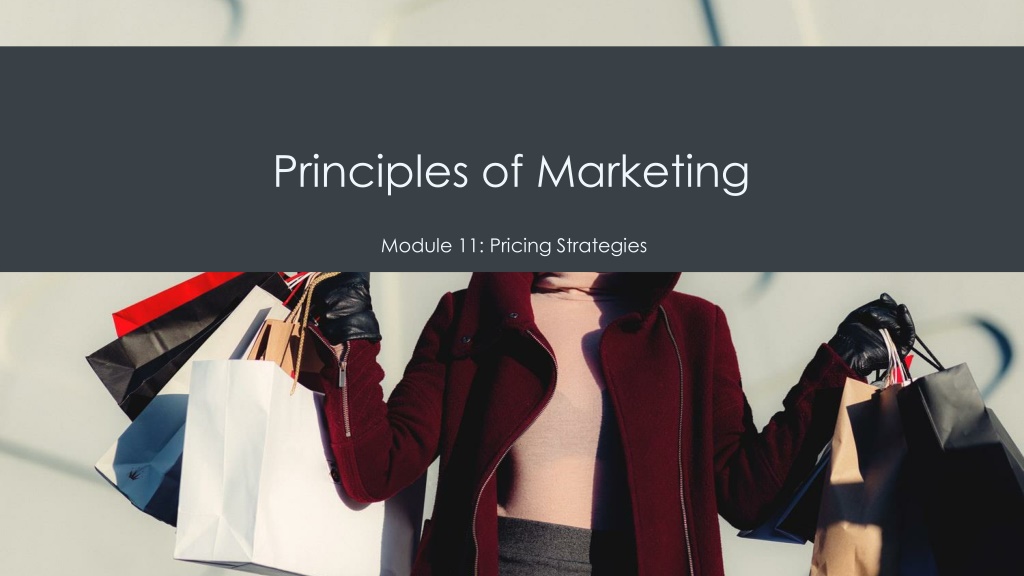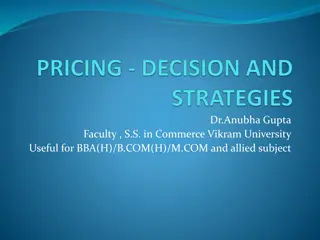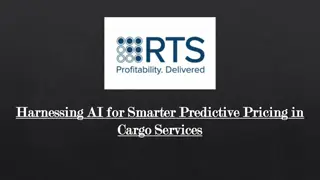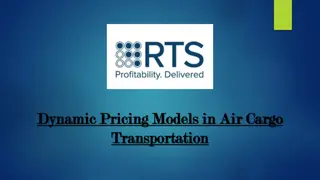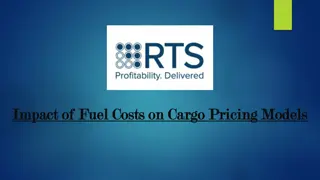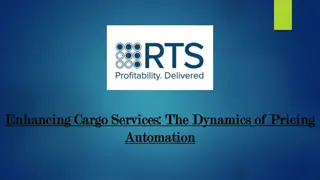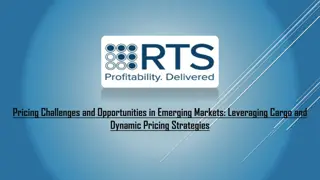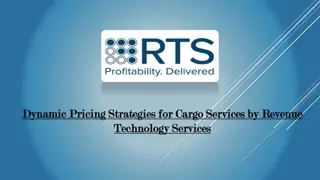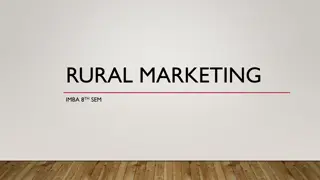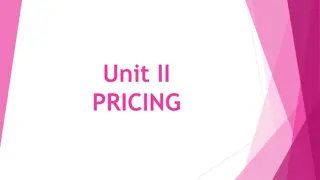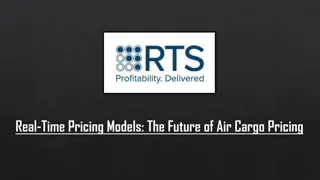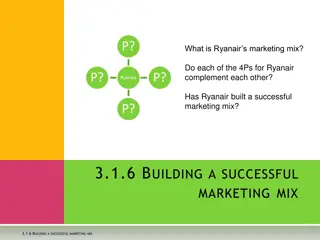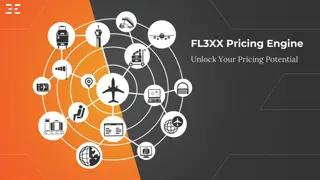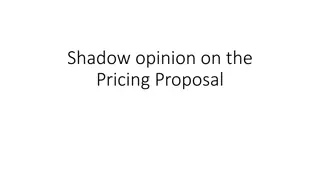Mastering Pricing Strategies in Marketing
Explore the psychology of pricing and various pricing strategies in marketing, including profit-oriented, competitor-oriented, and customer-oriented pricing. Learn about the importance of understanding how customers view prices, leveraging pricing anchoring, and conducting Van Westendorp Price Sensitivity Analysis. Discover how break-even pricing helps in determining the critical price point for covering costs, and delve into competitive pricing tactics to effectively position your offerings in the market.
Download Presentation

Please find below an Image/Link to download the presentation.
The content on the website is provided AS IS for your information and personal use only. It may not be sold, licensed, or shared on other websites without obtaining consent from the author.If you encounter any issues during the download, it is possible that the publisher has removed the file from their server.
You are allowed to download the files provided on this website for personal or commercial use, subject to the condition that they are used lawfully. All files are the property of their respective owners.
The content on the website is provided AS IS for your information and personal use only. It may not be sold, licensed, or shared on other websites without obtaining consent from the author.
E N D
Presentation Transcript
Principles of Marketing Module 11: Pricing Strategies
Psychology of Price Customers are more likely to buy products whose price points end in the number nine Anchoring can change customer perceptions of price
Pricing Strategies. 1.Profit-oriented pricing 2.Competitor-oriented pricing 3.Customer-oriented pricing
Profit Oriented Pricing Focus on finances of business and product profit = revenue - price Price per product is set higher than the total cost of producing and selling cost Ensures company makes a profit on each sale Risks Customers don t care about a company s costs Competitors can undercut pricing Limits pricing flexibility
Van Westendorp Price Sensitivity Questions 1.At what price would you consider the product to be so expensive that you would not consider buying it? (Too expensive) 2.At what price would you consider the product to be priced so low that you would feel the quality couldn t be very good? (Too cheap) 3.At what price would you consider the product starting to get expensive, such that it s not out of the question, but you would have to give some thought to buying it? (Expensive/High Side) 4.At what price would you consider the product to be a bargain a great buy for the money? (Cheap/Good Value)
Other Pricing Strategies Profit objective: For example, Increase net profit in 2016 by 5 percent Competitive objective: For example, Capture 30 percent market share in the product category
Break-Even Price The break-even price is the price that will produce enough revenue to cover all costs at a given level of production. p = (Vn + FC) / n n = FC /( p V) p is price n is number of units sold V is variable cost per unit FC is fixed costs
Competitive Pricing Matching competitor price requires competing on the other parts of the marketing mix Pricing above competition requires a clear advantage on some nonprice element of the marketing mix Pricing below the competition to increase sales volume with lower profit margins is effective if a significant segment of the market is price sensitive and/or the organization s cost structure is lower than competitors The risk of competing on price is a price war
Value-based Pricing Price is what you think your product is worth to that customer at that time. This approach regards the following as marketing/price truths: To the customer, price is the only unpleasant part of buying. Price is the easiest marketing tool to copy. Price represents everything about the product. Still, value-based pricing is not altruistic. It asks and answers two questions: What is the highest price I can charge and still make the sale? Am I willing to sell at that price?
Tactical Recommendations from Value-based Pricing Employ a segmented approach toward price that considers how each group of customers assesses value Establish the highest possible price level and justify it with comparable value Use price as one component in the marketing mix, building compelling value across all elements of the offering
Price Skimming A firm charges the highest initial price that customers will pay As the demand of the first customers is satisfied, the firm lowers the price to attract another, more price-sensitive segment
Price Skimming and Customer Segmentation Price skimming can also be part of a customer segmentation strategy.
Penetration Pricing The price of a product is initially set low to rapidly reach a wide fraction of the market and initiate word of mouth to enlarge market share and exploit economies of scale
Advantages of Penetration Pricing It can result in fast diffusion and adoption across the product life cycle It can create goodwill among the Innovators and Early Adopters It establishes cost-control and cost-reduction pressures from the start, leading to greater efficiency It discourages the entry of competitors and takes existing competitors by surprise It can generate high stock turnover throughout the distribution channel, which creates important enthusiasm and support in the channel
Disadvantages of Penetration Pricing Can create long-term price expectations for the product and image preconceptions for the brand and company that make it difficult to raise prices later low profit margins may not be sustainable long enough for the strategy to be effective
Cost-plus Pricing Cost-plus pricing, sometimes called gross margin pricing Most widely used pricing method The manager selects as a goal a particular gross margin that will produce a desirable profit level Gross margin is the difference between how much the goods cost and the actual price for which it sells This gross margin is designated by a percent of net sales The percent chosen varies among types of merchandise
Markup When middlemen use the term markup, they are referring to the difference between the average cost and price of all merchandise in stock, for a particular department, or for an individual item
Discounting Strategies Quantity discounts Seasonal discounts Cash discounts Trade discounts (given to middlemen) Personal allowances (rewards to salespeople) Trade-in allowances (cars) Price bundling (cable) package)
Price Elasticity Price elasticity measures the responsiveness of quantity demanded to a change in the product price % ? ???? ?? ???????? % ? ???? ?? ????? ????? ?????????? = When the absolute value of the price elasticity is >1, the price is elastic When the absolute value of the price elasticity is <1, the price is inelastic
What Determines Price Elasticity Substitutes Absolute price Importance of use Competitive dynamics
Competitive Bidding A competitive bid is a procurement process in which bids from competing suppliers are solicited Advertises the requirements and specifications of solutions and invites suppliers to provide a proposal about how they will meet the need and at what price. opportunity to tailor pricing for a specific customer s needs
Dont Compete on Price Alone Price is not a sustainable competitive advantage Low prices can jeopardize a company s ability to profitably deliver sustained value
Practice Question Compare and contrast price skimming and penetration pricing.
Quick Review How does price affect the value of the organization s products or services? What are the primary factors to consider in pricing? Compare common pricing strategies. What is price elasticity and how can it be used to set price? What is competitive bidding and how is it used for B2B pricing?
